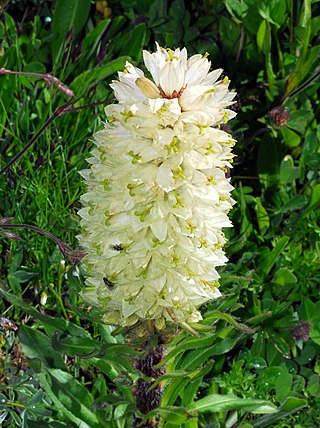
Eryngium alpinum, the alpine sea holly, alpine eryngo or queen of the Alps, is a herbaceous perennial plant in the family Apiaceae.

Aristolochia rotunda, commonly known as smearwort or round-leaved birthwort, is a herbaceous perennial plant native to Southern Europe.

A cyathium is one of the specialised pseudanthia forming the inflorescence of plants in the genus Euphorbia (Euphorbiaceae). A cyathium consists of:

Campanula rapunculoides, known by the common names creeping bellflower, rampion bellflower, rover bellflower, garden bluebell, creeping bluebell, purple bell, garden harebell, and creeping campanula, is a perennial herbaceous plant of the genus Campanula, belonging to the family Campanulaceae. Native to central and southern Europe and west Asia, in some parts of North America it is an extremely invasive species.

Anemone hortensis, commonly called broad-leaved anemone, is a perennial herbaceous flowering plant with an underground rhizome, in buttercup family Ranunculaceae. The genus name comes from the Greek ἄνεμος, as an ancient legend tells that the flowers open only when the wind blows. The species name hortensis refers to the easiness with which this plant can be cultivated.

Aster amellus, the European Michaelmas daisy, is a perennial herbaceous plant and the type species of the genus Aster and the family Asteraceae.

Clinopodium alpinum, the rock thyme, is a perennial plant of the family Lamiaceae. Subspecies of rock thyme include: C. alpinum meriodionale, with smaller flowers; and C. alpinum majoranifolium, which grows in smaller bunches. Rock thyme is sometimes used in pharmacology for its diaphoretic and antipyretic properties. In addition, it can be brewed and served as tea.

Campanula spicata, common name the spiked bellflower, is a herbaceous biennial or perennial plant of the genus Campanula belonging to the family Campanulaceae.

Stachys recta, commonly known as stiff hedgenettle or perennial yellow-woundwort, is herbaceous perennial plant of the family Lamiaceae.

Rubia peregrina, the common wild madder, is a herbaceous perennial plant species belonging to the bedstraw and coffee family Rubiaceae.

Viola bertolonii is a species of violet known by the common name Bertoloni's pansy, belonging to the Violaceae family.

Achillea erba-rotta, common name simple leaved milfoil, is a perennial flowering plant of the genus Achillea, belonging to the sunflower family.

Rhaponticum scariosum, common name giant scabiosa, is a perennial herbaceous flowering plant of the genus Rhaponticum of the family Asteraceae.

Leuzea rhapontica subsp. heleniifolia, synonym Rhaponticum heleniifolium, is a flowering plant in the genus Leuzea of the family Asteraceae.

Rhamnus alaternus is a species of flowering plant in the buckthorn family Rhamnaceae, known by the common names Italian buckthorn or Mediterranean buckthorn. It is a hardy medium-sized evergreen shrub with fragrant flowers.

Cirsium erisithales, the yellow thistle or yellow melancholy thistle, is a perennial herbaceous plant in the tribe Cardueae within the family Asteraceae.

Senecio ovatus, common name wood ragwort, is a perennial herbaceous plant belonging to the family Asteraceae.

Jacobaea incana, the grey ragwort, is a species of Jacobaea in the family Asteraceae.

Campanula thyrsoides is a flowering plant belonging to the family Campanulaceae.

Phyteuma betonicifolium, common name betony-leaved rampion, is a species of flowering plant in the family Campanulaceae.





















